Additional revision of Jeju 4·3 Special Act needed for victims of guilt-by-association system
NEWS FOCUS 3
Additional revision of Jeju 4·3 Special Act needed
for victims of guilt-by-association system
Jwa Dong-cheol, Deputy Editor of The Jeju Ilbo

Á¦ÁÖ4.3ÀÇ Á¤ÀǷοî ÇØ°áÀ» À§ÇÑ Åä·Ðȸ
(¼¿ï=¿¬ÇÕ´º½º) ÇÏ»çÇå ±âÀÚ = Á¦ÁÖ4.3Ưº°¹ý ÀüºÎ °³Á¤ 1Áֳ⠱â³ä Á¦ÁÖ4.3ÀÇ Á¤ÀǷοî ÇØ°áÀ» À§ÇÑ Åä·Ðȸ°¡ 17ÀÏ ¿ÀÈÄ ¼¿ï ¿©Àǵµ ±¹È¸ µµ¼°ü¿¡¼ ¿¸®°í ÀÖ´Ù. 2023.1.17
toadboy@yna.co.kr/2023-01-17 14:48:49/
Discussion for just resolution of Jeju 4·3 held at National Assembly Library
Revision of Jeju 4·3 Special Act needed to grant compensatory damages to victims’ spouses and children excluded due to inaccurately registered family relationships
Provincial office to place staff in Osaka for payment of compensation to victims in Japan
Lawsuit to provide compensatory damages to 100,000 victims’ families difficult to be filed individually
Complementary revision of the Jeju 4·3 Special Act has been suggested for the recovery of damages that the spouses and children of Jeju 4·3 victims suffered due to inaccurate family relationships and the guilt-by-association system.
On Jan. 17, 2023, a forum to commemorate the first anniversary of the general revision of the Jeju 4·3 Special Act was held under the theme of “Just Resolution of Jeju 4·3” in the conference hall of the National Assembly Library, Seoul. The event was co-hosted by Jeju Special Self-Governing Province, the Jeju Special Self-Governing Provincial Council, the Jeju Special Self-Governing Provincial Office of Education, and the offices of Rep. Wi Sung-gon, Rep. Song Jae-ho, and Rep. Kim Han-kyu (National Assembly members from the Democratic Party of Korea).
Yang Seong-ju, secretary-general of the Association of the Bereaved Families of Jeju 4·3 Victims, pointed out that although the revised Jeju 4·3 Special Act requires the payment of up to 90 million won to each of the Jeju 4·3 victims in compensatory damages, no clauses exist concerning the recovery of damages their spouses and children suffered. “The government says that the revision enabled lawsuits to claim the recovery of damages for victims’ families, but filing an individual lawsuit is not easy, given that there are more than 100,000 people who lost their loved ones due to Jeju 4·3.
Yang referred to the civil lawsuit wherein the court ruled that the plaintiffs (victims and their families) shall be paid consolation money of 100 million won for each deceased victim, 50 million won for the victim’s spouse, and 10 million won for each of the victim’s children. “It is realistic to revise the Jeju 4·3 Special Act to specify the en bloc payment of the consolation money based on the preceding court judgment,” he claimed. He reminded the audience that the Jeju 4·3 Special Act defines the period of Jeju 4·3 as spanning from March 1, 1947, to Sept. 21, 1954, based on which the victim’s eligibility for compensation payment is determined. As he indicated, however, the law specifies no remedy for those who suffered state-inflicted damage under the charge of engaging in activities to discover the truth of Jeju 4·3 and restore honor to the victims.
Concluding his statement, Yang called for an additional revision of the Jeju 4·3 Special Act to include clauses on compensating for damages to those who were implicated in the fabricated North Korean spy cases during the period after the statutory Jeju 4·3 period.
Jeju 4·3 Special Act needs to be revised to reflect opinions of victims’ families
Kim Se Eun defended the plaintiffs in the first lawsuit for national compensation in accordance with the Jeju 4·3 retrial, wherein the court ruled in favor of the Jeju 4·3 victims. The human rights lawyer claimed that it is reasonable to revise the Jeju 4·3 Special Act to reflect the opinions of victims’ families that those unrecognized due to the guilt-by-association system should be able to receive compensatory damages.
As did Yang Seong-ju, Kim also referred to the legal ground for her argument to the civil court ruling (Case No. 2021Na 11079), wherein the national government pays consolation money worth 100 million won for a victim, 50 million won for the victim’s spouse, and 10 million won for each of the victim’s children, as the legal grounds of her argument. In the case, one of the defendants was imprisoned twice due to Jeju 4·3, the first from May 1949 to March 1950 and the second from May 1954 to April 1965, for a total of 4,411 days in prison. The Jeju District Court judged that the government should pay consolation money not only to the victim but also to his wife and children, especially given that the children experienced considerable mental suffering for a dozen years from infancy to adolescence due to the absence of their father.
Lawyer Kim expected that in light of the litigation in practice, subsequent Jeju 4·3 lawsuits will highly likely recognize consolation money not far off the amount recognized in the preceding litigation. In this regard, she agreed that there is a need to collect opinions from victims’ families and revise the Jeju 4·3 Special Act to create clauses on the compensatory damage. She added, however, that the plaintiff(s), mostly the deceased victims’ families, will be held responsible for the verification of the facts they claim to be true, and that seeking compensation following the litigation procedures tends to require a substantial amount of time. This is why the national government needs to take responsible action to find a remedy in advance, she stressed.
Currently, the Ministry of the Interior and Safety is conducting research through an external agency to devise measures to correct the distorted family relationship registers of Jeju 4·3 victims. A suggestion was made for the same purpose during the forum, which relates to the need to revise the Jeju 4·3 Special Act to include a relevant clause before the official period for the payment of national compensation is terminated. This is because during the chaotic turmoil of Jeju 4·3, many Jeju residents made registrations for marriage, births, and deaths which differed from the facts so that they could avoid any damage that could be caused by the guilt-by-association system.
For example, there was a case where a resident reported that his parents had died of old age in the 1960s, although in fact, they had been killed at the time of Jeju 4·3. In this case, his parents’ actual deaths (1948), their registered deaths (1960), their belated marriage registration (1959), and their son’s birth registration (1960) are distorted. If the inaccurate family relationship is corrected, the deceased victims’ marriage registration and the registration of their child’s birth will become invalid. To address this issue to some extent, the Supreme Court enforced a rule, starting from July 2022, that broadened the range of cases applicable to the correction of family relation registers.
However, Lawyer Kim Se Eun said that if, for example, a victim of an unlawful conviction due to Jeju 4·3 survived Jeju 4·3 (1947-1954) but died suddenly in 1975, his or her biological children who had been adopted by other families to avoid the guilt-by-association system are unable to correct their inaccurate family relation registers. This gives reason to complement the recently enforced Supreme Court rule, Kim pointed out.
Another suggestion for the improvement of the Jeju 4·3 Special Act involves the retrial of victims of unlawful courts-martial. Since the first retrial began in 2019, 581 victims have been acquitted and exonerated. However, in the cases of those convicted in general trials, the deceased victims without living family members are unable to file a lawsuit even with the existence of the clause on special retrials which was added to the recently revised Jeju 4·3 Special Act. Special retrials regard those identified as Jeju 4·3 victims as eligible applicants, while ex officio retrials are to be filed concerning 2,530 victims who were unlawfully convicted at the courts-martial.
The forum also raised the issue of implicit discrimination against Jeju 4·3 victims. Although the clauses of the Jeju 4·3 Special Act presuppose no discrimination against the victims, the Jeju 4·3 Peace Park fails to enshrine the memorial tablets of some victims in its Memorial Tablet Enshrinement Hall. With regard to this, a participant in the forum insisted that authorities prepare remedies for those who have been implicitly excluded to be recognized as Jeju 4·3 victims following the 2001 Constitutional Court judgment. Kang Min-cheol, director of the Jeju Special Self-Governing System Task Force (former chief of the Jeju 4·3 Support Division), Jeju Special Self-Governing Province, said that Jeju Province will place a staff member in the South Korean Consulate General in Osaka, Japan, to smoothly handle applications for payment of national compensation submitted by victims’ families in Japan.
The provincial government plans to hire a local staff member who is fluent in both Korean and Japanese and place the staff member in the South Korean Consulate General as early as March. Currently, it is estimated that some 900 family members of Jeju 4·3 victims reside in Japan. As most of them are in their 80s, they are having difficulties applying for compensation, especially in notarizing their family relation registers in Japanese before submission. The deployment of dedicated staff will help the victims’ families living in Japan to apply for national compensation and encourage more victims and bereaved families to apply for recognition of eligibility.
Prior to the forum, Heo Sang-su (former professor at Sungkonghoe University) spoke on the topic of “A Task for International Resolution of the Great Incident on April 3,” followed by Lee Chang-su (CEO of the Institute for Law, Human Rights, and Society), who gave a presentation titled “Tasks for Just Solution of Past Misconduct and Jeju 4·3.” Lee Kyu-bae (president of the Jeju 4·3 Research Institute) presided over the subsequent panel discussion, which featured panelists which included Han Kwon (chairperson of the Jeju 4·3 Special Committee, Jeju Special Self-Governing Provincial Council), Kang Min-cheol (former chief of the Jeju 4·3 Support Division, Jeju Special Self-Governing Province), Hong Il-sim (school inspector in the Democratic Citizenship Education Division, Jeju Special Self-Governing Provincial Office of Education), Kim Dong-hyun (head director of the Jeju People’s Artist Federation), Kim Se Eun (lawyer, Haemaru Law Firm), Yang Seong-ju (secretary general of the Association of the Bereaved Families of Jeju 4·3 Victims), and Lee Chang-su (CEO of the Institute for Law, Human Rights, and Society).
++ A forum to commemorate the first anniversary of the general revision of the Jeju 4·3 Special Act is held at the National Assembly Library.
++ Materials are distributed to the participants of the forum on Jan. 17, 2023, in the conference room of the National Assembly.
++ Materials are distributed to the participants of the forum on Jan. 17, 2023, in the conference room of the National Assembly.
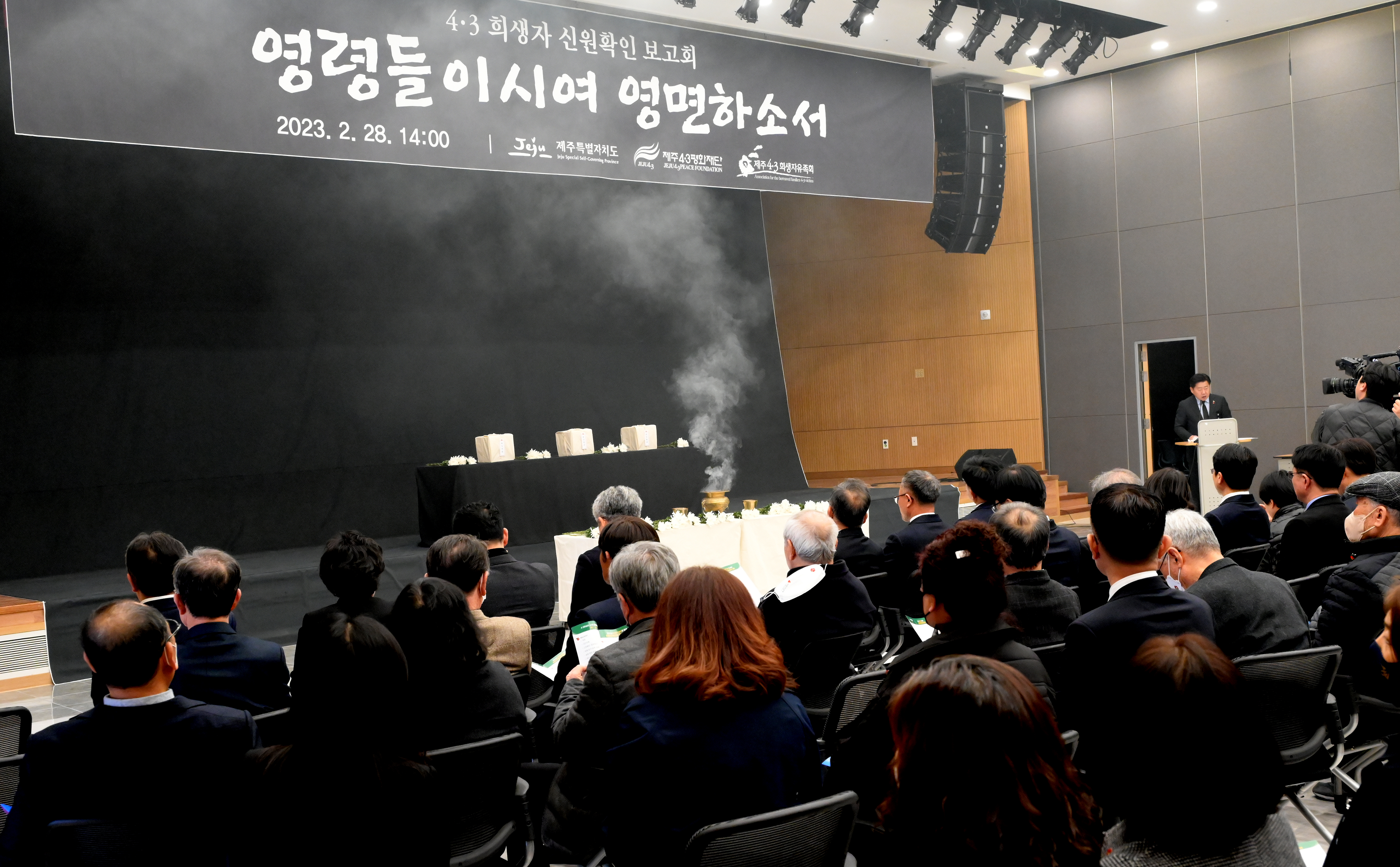
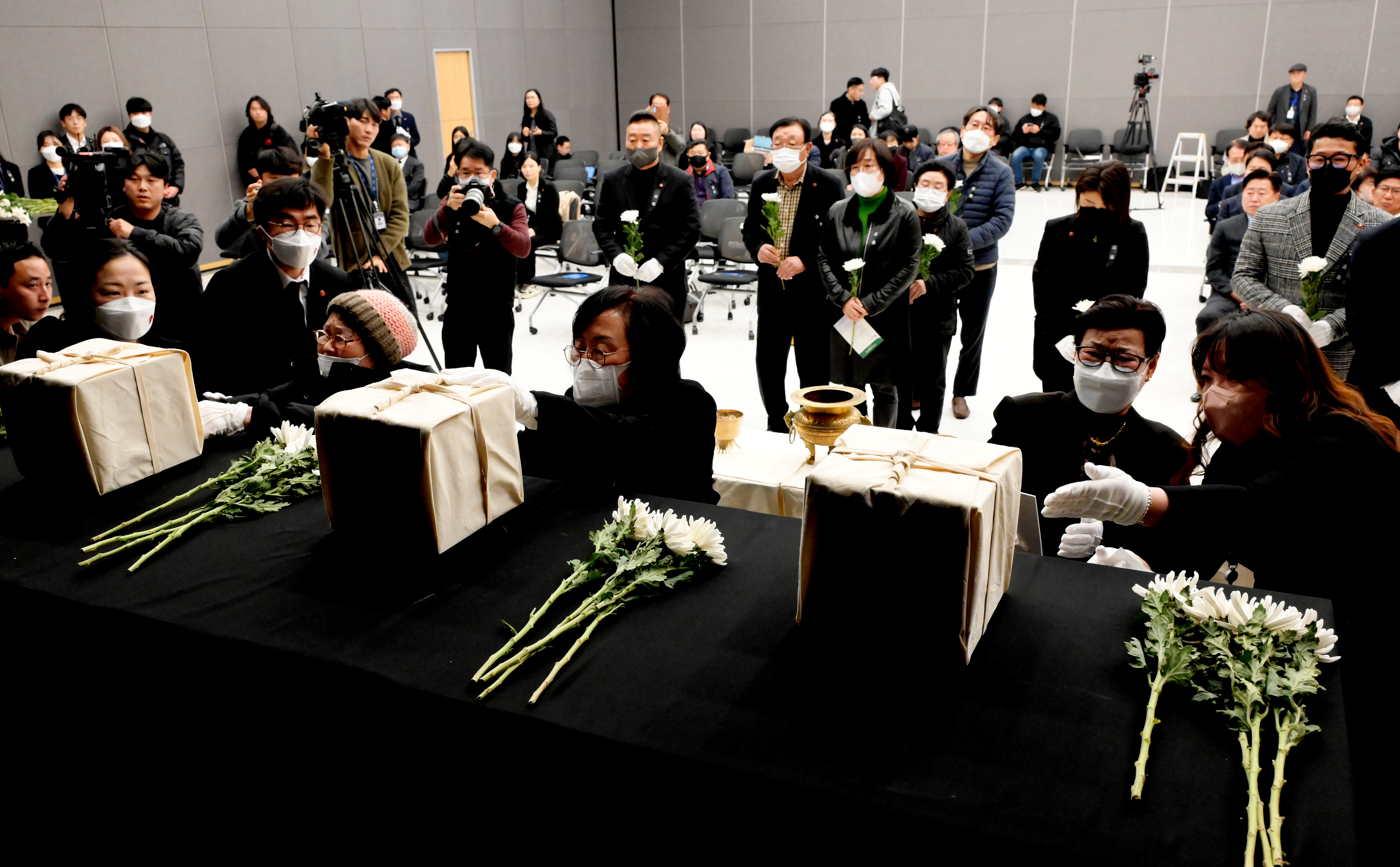
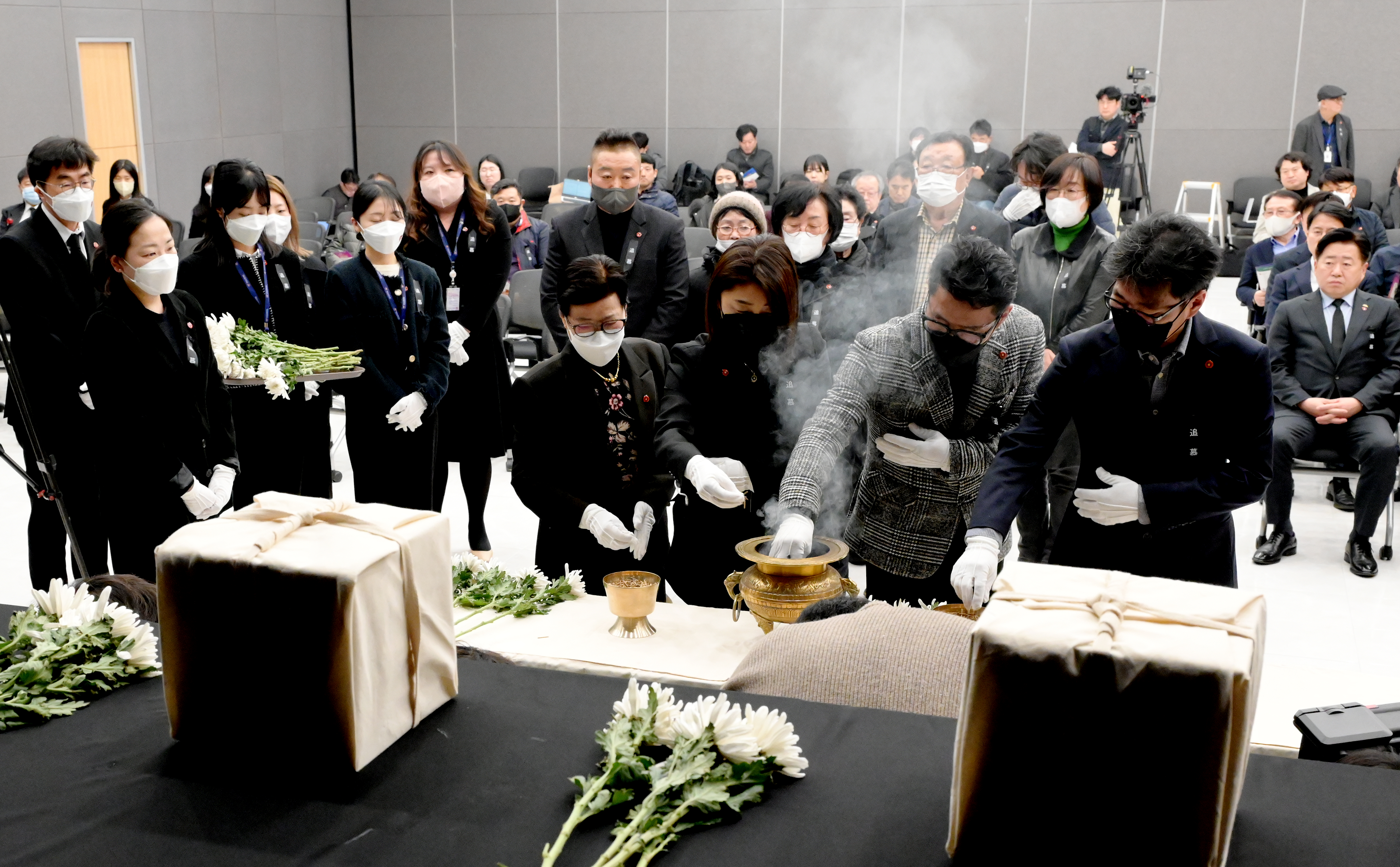 The Reporting Session on the Exhumed Remains Identified as Jeju 4·3 Victims was held on Feb. 28, 2023. With reverence and solemnity, those gathered in the Jeju 4·3 Peace Education Center faced the remains of Jeju 4·3 victims who returned to their families 75 years after their disappearance.
The Reporting Session on the Exhumed Remains Identified as Jeju 4·3 Victims was held on Feb. 28, 2023. With reverence and solemnity, those gathered in the Jeju 4·3 Peace Education Center faced the remains of Jeju 4·3 victims who returned to their families 75 years after their disappearance.
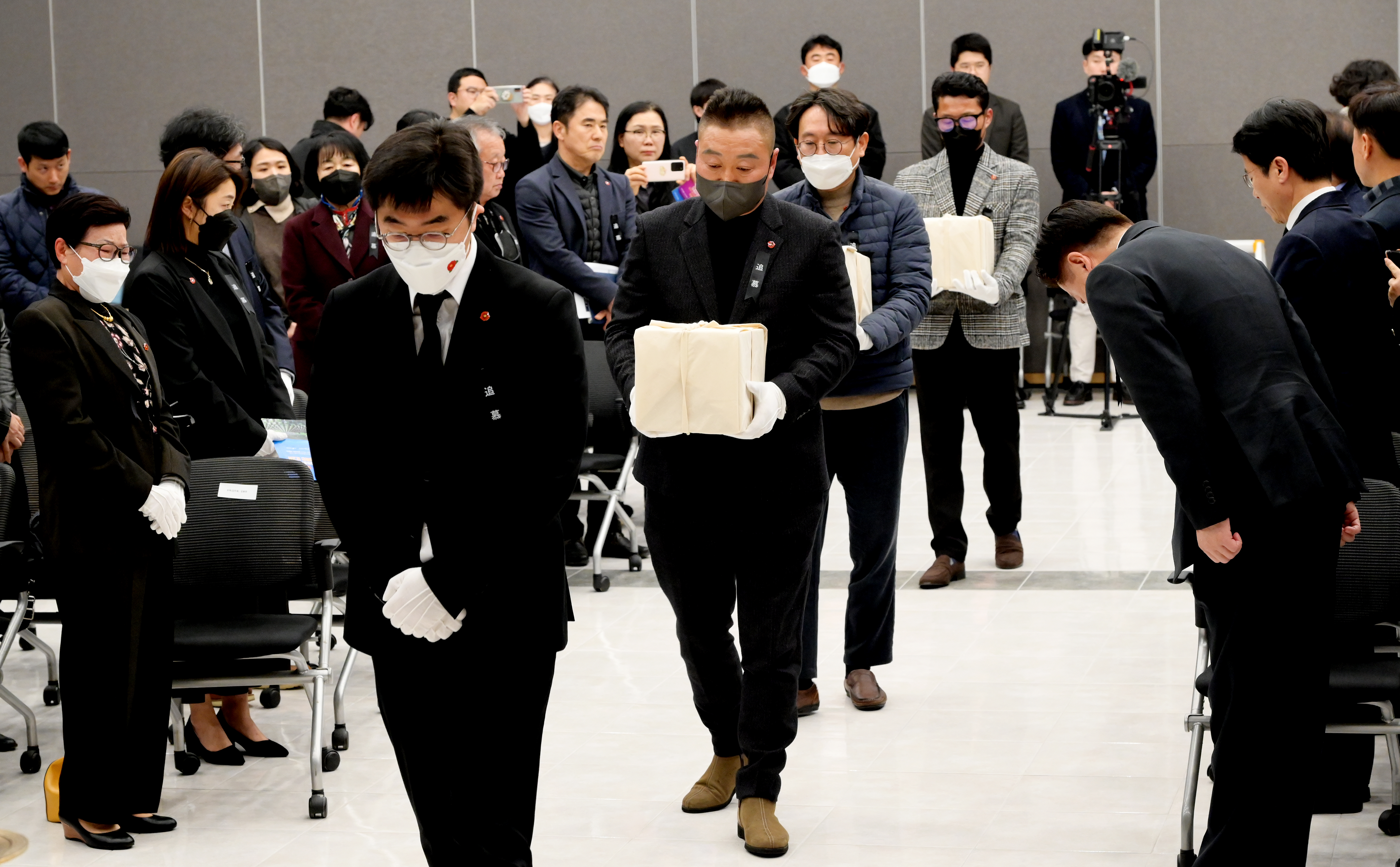



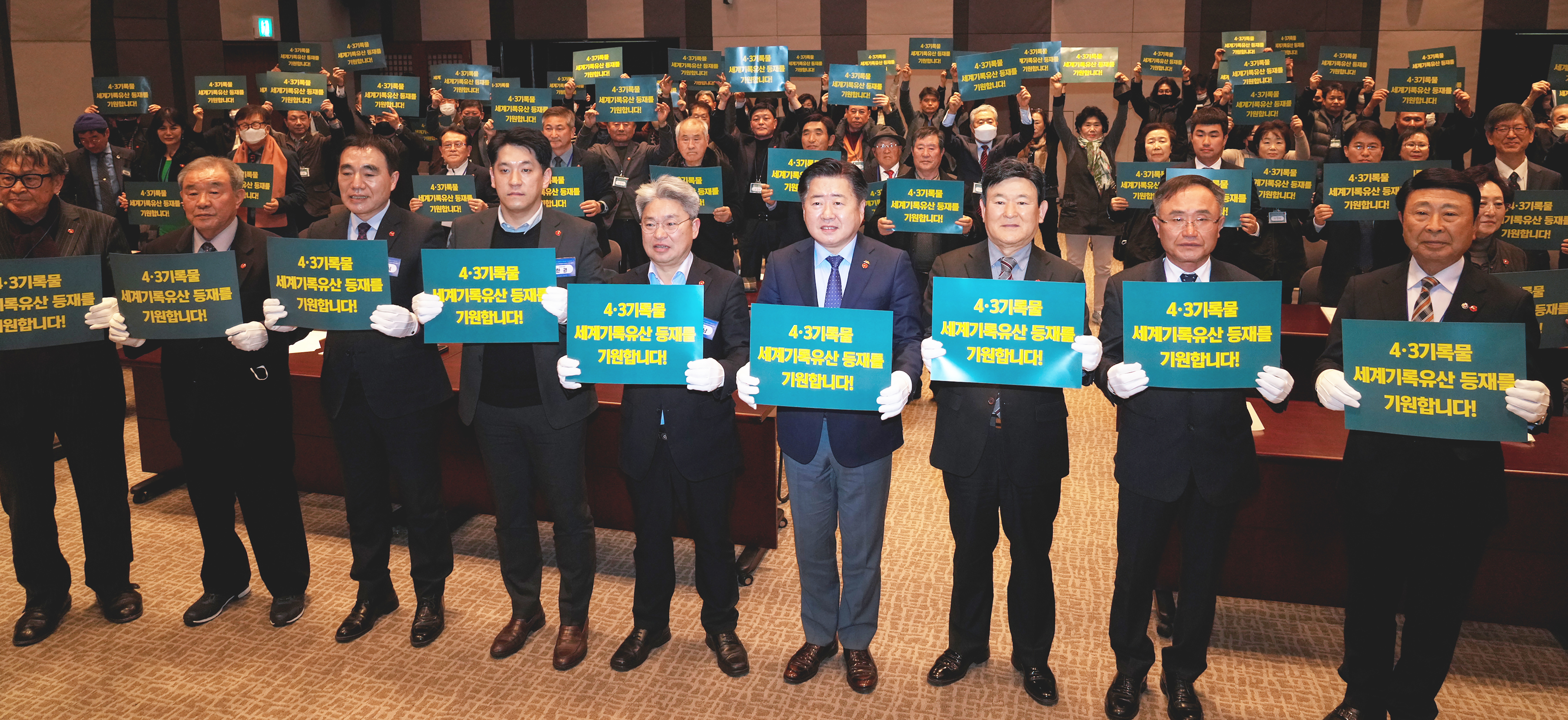

 The official event began with the screening of a video of the late Jin A-yeong [a symbolic Jeju 4·3 victim who used to cover her crushed lower jaw with a cotton cloth], followed by the recital of “Lady Cotton Cloth” [a tribute poem for Jin A-yeong] by its author, Heo Young-sun. Moon Hye-hyeong, a Jeju 4·3 victim’s family member, was invited to read her story related to the documentary heritage of Jeju 4·3. Lastly, a joint declaration was read and the Jeju 4·3 MoW Inscription Promotional Committee was launched.
The official event began with the screening of a video of the late Jin A-yeong [a symbolic Jeju 4·3 victim who used to cover her crushed lower jaw with a cotton cloth], followed by the recital of “Lady Cotton Cloth” [a tribute poem for Jin A-yeong] by its author, Heo Young-sun. Moon Hye-hyeong, a Jeju 4·3 victim’s family member, was invited to read her story related to the documentary heritage of Jeju 4·3. Lastly, a joint declaration was read and the Jeju 4·3 MoW Inscription Promotional Committee was launched.



 ++ Jeju 4·3 materials included on the list of documentary heritage for the application for the MoW inscription. Claim for Jeju 4·3 Victim’s Status (first), List of Convicted Prisoners (second), and postcards sent from prison (third). Cabinet minutes (fourth and fifth),
++ Jeju 4·3 materials included on the list of documentary heritage for the application for the MoW inscription. Claim for Jeju 4·3 Victim’s Status (first), List of Convicted Prisoners (second), and postcards sent from prison (third). Cabinet minutes (fourth and fifth),